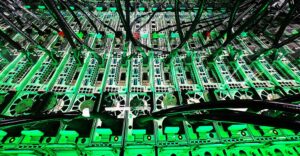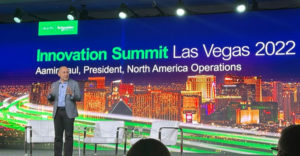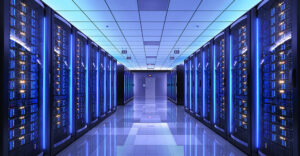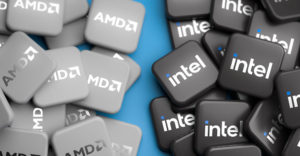Google’s annual environmental report released Monday showed the company continued to meet its goals for renewable energy use but still had a ways to go to meet its pledge to give back to communities more water than it’s taking out of them to cool its data centers and supply its offices.
For the sixth year in a row, the company matched 100% of its annual global electricity use with renewable energy purchases, according to the 104-page report.
“We are now working to address the issue that renewable energy is not available all the time and everywhere by aiming to run on carbon-free energy 24/7 and to achieve net-zero emissions across all of our operations and value chain by 2030,” Learning & Sustainability Senior Vice President Ben Gomes and Chief Sustainability Officer Kate Brandt wrote in a Google blog.
The report also noted that through the company’s contracted watershed projects, it had replenished 271 million gallons of water — equivalent to more than 400 Olympic-sized swimming pools — to support its target to replenish 120% of the freshwater it uses in its global operations by 2030.
Google will have to hustle to meet that goal, however, since that 271 million gallons is only 6% of the company’s freshwater consumption in 2022.
Thirsty Data Centers
Google directs most of its water consumption towards cooling its global server network. Water cooling nets the company two benefits, according to the report. “We’ve found that our water-cooled data centers use about 10% less energy and emit roughly 10% less carbon emissions than our air-cooled data centers,” it explained.
In 2022, Google reported, the total water consumption by its data centers and offices was 5.6 billion gallons — the equivalent of what it takes to irrigate 37 golf courses annually, on average, in the southwestern United States. Google was careful to note, however, wherever feasible, it tries to use non-potable sources of freshwater and alternatives to freshwater
In addition, it explained that it also evaluates and takes into account local water stress when deciding where to locate its facilities, how to design them, and how to operate them — from water systems in its offices to cooling systems in its data centers.
“That’s why, in 2022, 82% of our freshwater withdrawals came from regions with low water stress,” it added.
Amazon Web Services also considers water stress levels when locating its data centers. “In certain places, we might look at the community and decide it’s not the right thing for us to use water to cool our data centers,” explained AWS Global Lead for Water Will Hewes.
“There are alternatives. They just require us to use more energy,” he told TechNewsWorld.
Cooling Alternatives
Wes Swenson, a founder, investor, and CEO of Novva Data Centers, a privately-held data center company based in West Jordan, Utah explained that if water is a finite resource in any given area, and data centers enter the community, and they use water for evaporative chilling, then they can increase the pressure on water inventory.
But scarcity is just one point of concern, he added. “If the data center uses air-side economizers and the outside ambient air is entering the data center, the water is treated for minerals or hard water, and bacteria treatment, as it will be inhaled by employees,” he told TechNewsWorld.
“Water that is not lost to evaporation is flushed into the city’s wastewater system, where it must either be retreated or shifted to irrigation uses,” he continued. “It takes massive energy use to clean it and reclean it.”
“If the water is consumed for fluid side economizers, then it is treated for hard water minerals, and the outside air does not enter the data center. But again, the water that was not lost to evaporation is flushed into the city’s wastewater system, putting increased pressure on wastewater plants,” he added.
Although data centers primarily use water for cooling, they can also use air cooling as an alternative, noted Adam Simmons, a content provider for Data Center Knowledge, an online source of information on the data center industry.
“The problem is air is a less efficient cooling mechanism than water,” he told TechNewsWorld. “Air also doesn’t work in hot environments, so it’s not going to work as well in Arizona and Texas as it might in Canada or Northern Europe.”
“There’s also liquid immersion cooling, where you submerge the equipment in some kind of non-conducting liquid,” he added. “That has challenges, too. It’s newer. It’s more expensive, and it has maintenance issues because you can’t upgrade the equipment while it’s submerged.”
AI Impact on Data Center Water Demand
Simmons pointed out that water-free systems have been around for years. “The argument against them is that they use more energy to run the systems than water systems, which is a myth,” he said.
“Clients of data centers could also be more wise in terms of cooling,” he added. “Raising operating temperatures would help, for instance, moving the thermostat from 70 to 80 degrees.”
If Google’s and everyone else’s data centers are thirsty for water now, that thirst could worsen as the demand to run artificial intelligence models increases. “AI will increase the demand for water by data centers significantly,” maintained Rob Enderle, president and principal analyst at the Enderle Group, an advisory services firm in Bend, Ore.
“AI uses a lot of processing power. Processing power generates heat and needs additional cooling,” he told TechNewsWorld.
Swenson asserted that it is likely that AI models will impact water unless data centers change their methods. “AI and new inferred compute loads with a multiplier effect will likely cause data centers to be built 10 times current levels, and possibly 20 to 25 times, over just the next five years,” he predicted.
Offsetting Demand With Efficiency
Hewes acknowledged that there may be some growth in water usage over time attributable to AI. “But AWS will continue to invest in water efficiency so we can minimize any growth in water,” he said.
He noted that in 2021, AWS data centers used about 0.25 liter of water per kilowatt hour. In 2022, it lowered that to 0.19 liter per kilowatt hour.
“Our goal is even with water growth, we will have a net positive impact,” he observed.
John DeVoe, a senior fundraiser and advisor of WaterWatch of Oregon, a water quality monitoring organization in Portland, Ore., cautioned that corporate promises about water usage have to be carefully scrutinized.
“What do they mean by replenish?” he asked.
“Amazon had a program in Oregon where they were putting water they had been using for cooling and putting it into irrigation canals and calling that mitigation,” he told TechNewsWorld. “But that does nothing for the sources of that water — a river, stream, or aquifer.”
“There’s no water going back to those sources,” he continued, “and even if it did, it would kill the fish living there.”
Update – July 27, 2023:
However, AWS noted in a blog that to ensure the water quality is maintained in the reuse system at its irrigation project in Oregon. The company has installed water quality sensors to capture data used for analysis and automated alarming.
“These IoT services provide both AWS and the surrounding communities with peace of mind that water quality is maintained and always suitable for irrigation,” the company stated. “The water reuse system makes millions of gallons of water each year available for the first time to farmers and residents in Umatilla and Morrow counties.”

























































